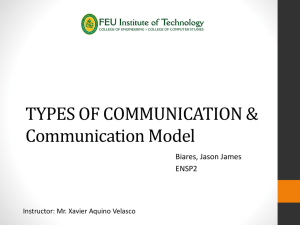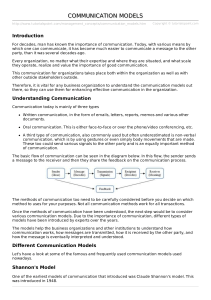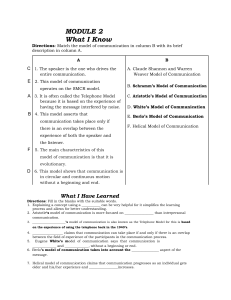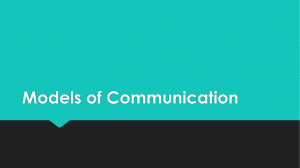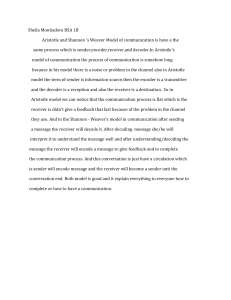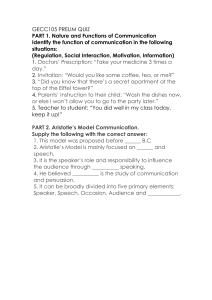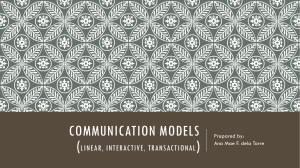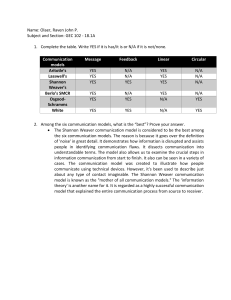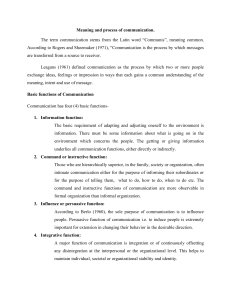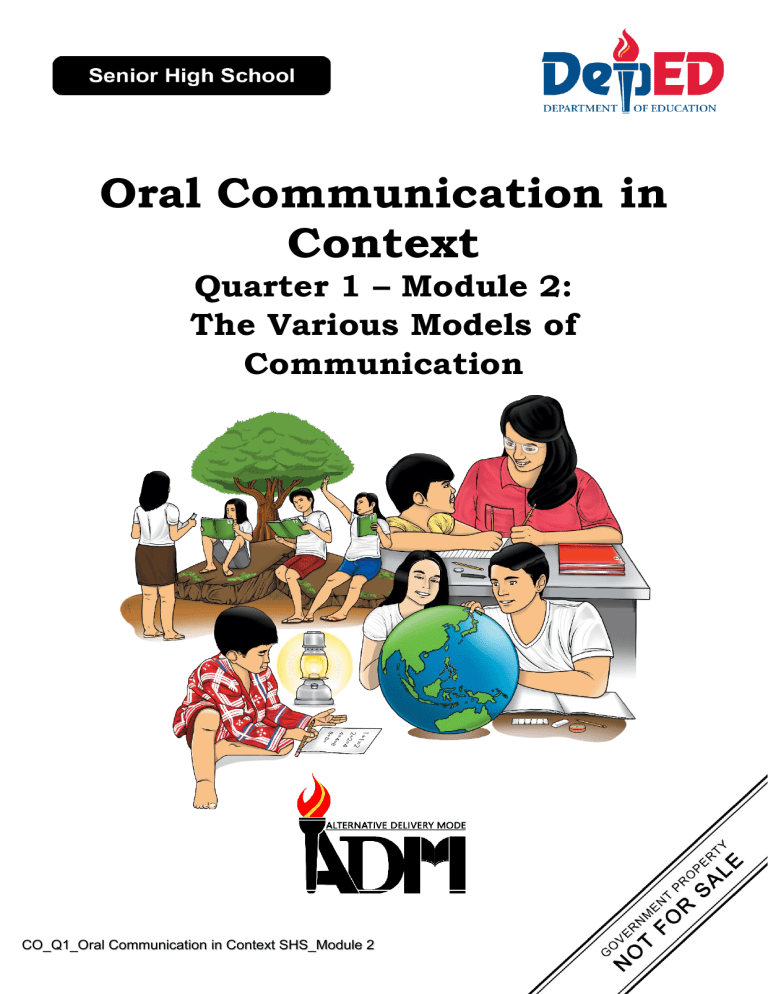
Oral Communication in Context Quarter 1 – Module 2: The Various Models of Communication CO_Q1_Oral Communication in Context SHS_Module 2 Oral Communication in Context Alternative Delivery Mode Quarter 1 – Module 2: The Various Models of Communication First Edition, 2020 Republic Act 8293, section 176 states that: No copyright shall subsist in any work of the Government of the Philippines. However, prior approval of the government agency or office wherein the work is created shall be necessary for exploitation of such work for profit. Such agency or office may, among other things, impose as a condition the payment of royalties. Borrowed materials (i.e., songs, stories, poems, pictures, photos, brand names, trademarks, etc.) included in this module are owned by their respective copyright holders. Every effort has been exerted to locate and seek permission to use these materials from their respective copyright owners. The publisher and authors do not represent nor claim ownership over them. Published by the Department of Education Secretary: Leonor Magtolis Briones Undersecretary: Diosdado M. San Antonio Development Team of the Module Writer: Julius Cezar D. Napallatan Editor: Joselito E. Calios Reviewers: Joselito E. Calios, Wilma Q. Del Rosario, Jenorie P. San Agustin, Arlene I. Donor, Aillen G. Sumagaysay, Illustrator: Hannah Krystelle Q. Del Rosario, Ernesto D. Tabios Lay-out Artists: Elinette B. Dela Cruz, Fegenius N. Rosas Management Team: Wilfredo E. Cabral, Micah S. Pacheco, Dennis M. Mendoza Ma. Evalou Concepcion A. Agustin, Carolina T. Rivera Manuel A. Laguerta, Joselito E. Calios, Wilma Q. Del Rosario Printed in the Philippines by ________________________ Department of Education – National Capital Region Office Address: Telefax: E-mail Address: Misamis St., Bago Bantay, Quezon City 02-929-0153 depedncr@deped.gov.ph Oral Communication in Context Quarter 1 – Module 2: The Various Models of Communication Introductory Message This Self-Learning Module (SLM) is prepared so that you, our dear learners, can continue your studies and learn while at home. Activities, questions, directions, exercises, and discussions are carefully stated for you to understand each lesson. Each SLM is composed of different parts. Each part shall guide you step-bystep as you discover and understand the lesson prepared for you. Pre-tests are provided to measure your prior knowledge of lessons in each SLM. This will tell you if you need to proceed with completing this module or if you need to ask your facilitator or your teacher's assistance for a better understanding of the lesson. At the end of each module, you need to answer the post-test to selfcheck your learning. Answer keys are provided for each activity and test. We trust that you will be honest in using these. In addition to the material in the main text, notes to the teacher are also provided to our facilitators and parents for strategies and reminders on how they can best help you with your home-based learning. Please use this module with care. Do not put unnecessary marks on any part of this SLM. Use a separate sheet of paper in answering the exercises and tests. And read the instructions carefully before performing each task. If you have any questions in using this SLM or any difficulty in answering the tasks in this module, do not hesitate to consult your teacher or facilitator. Thank you. ii What I Need to Know This module was designed to make you better understand and differentiate the various models of communication. As you go through this module, you are expected to design and perform effective controlled and uncontrolled oral communication activities based on context. What I Know Directions: Match the model of communication in column B with its brief description in column A. A B 1. The speaker is the one who drives the entire communication. A. Claude Shannon and Warren Weaver Model of Communication 2. This model of communication B. Schramm’s Model of Communication operates on the SMCR model. 3. It is often called the Telephone Model because it is based on the experience of having the message interfered by noise. C. Aristotle’s Model of Communication 4. This model asserts that E. Berlo’s Model of Communication D. White’s Model of Communication communication takes place only if F. Helical Model of Communication there is an overlap between the experience of both the speaker and the listener. 5. The main characteristics of this model of communication is that it is evolutionary. 6. This model shows that communication is in circular and continuous motion without a beginning and end. 1 CO_Q1_Oral Communication in Context SHS Module 2 Lesson 2 The Various Models of Communication What’s In One of the best ways to understand the various models of communication is to show them graphically. Explaining a concept using a graph can be very helpful because it simplifies the learning process and allows for better understanding. What’s New Directions: Compare and contrast the pictures below. Which of the two situations shows a more effective communication? Why do you think so? https://www.sacurrent.com/thedaily/archives/2018/09/05/beto-orourke-makes-appearance-on-the-ellen-degeneresshow 2 CO_Q1_Oral Communication in Context SHS Module 2 https://www.sacurrent.com/thedaily/archives/2018/09/05/beto-orourke-makes-appearance-on-the-ellendegeneres-show What is It The following are different models of communication that explain and illustrate how the process of communicating works. a. Aristotle’s Model of Communication Aristotle (5 BCE), a teacher of Rhetoric and a founder of an academy that produced good speakers, came up with the first and earliest model of communication. This model is more focused on public speaking than interpersonal communication. Speaker plays a very important role in public speaking. To influence or persuade his audience, he must first prepare his speech and analyze the audience before he speaks to them. SPEAKER MESSAGE AUDIENCE Aristotle’s Model of Communication 3 CO_Q1_Oral Communication in Context SHS Module 2 b. Transactional Model In the transactional model, there is an exchange of messages between the sender and the receiver where both take turns in sending and receiving messages. The roles of both communicators reverse each time in the communication process. This is also called circular model of communication and is used for interpersonal communication. Everyday talk and interactions are examples of transactional model of communication. The participants in this communication process who have common social and cultural systems and relational situations can communicate with one another more effectively. A teacher discussing a lesson with his students or teachers holding a virtual meeting communicate with one another efficiently because they know each other and share the same social system. The model shows that there is a continuous exchanging of messages, but barriers may take place and affect communication. Transaction Model Source: https://www.businesstopia.net/communication/transactional-model-communication c. Shannon – Weaver’s Model of Communication Claude Shannon and Warren Weaver introduced the concept of noise. This model of communication is also known as the Telephone Model for this is based on the experience of using the telephone back in the 1940’s wherein the message was hindered by noise. Therefore, the message received by the listener was not necessarily the message sent by the sender. The Shannon – Weaver model of communication contains six important features. Sender The originator of message or the information source selects desire message. Encoder The transmitter which converts the message into signals 4 CO_Q1_Oral Communication in Context SHS Module 2 Note: The sender’s messages converted into signals like waves or binary data which is compactable to transmit the messages through cables or satellites. For example: In telephone, the voice is converted into wave signals and it transmits through cables Decoder The reception place of the signal which converts signals into message, a reverse process of encode Note: The receiver converts those binary data or waves into message which is comfortable and understandable for receiver. Otherwise, receiver can’t receive the exact message, and it will affect the effective communication between sender and receiver Receiver The destination of the message from sender Note: Based on the decoded message the receiver gives their feedback to sender. If the message is distracted by noise, it will affect the communication flow between sender and receiver Noise The messages are transferred from encoder to decoder through channel. During this process the messages may be distracted or affected by physical noise like horn sounds, thunder, and crowd noise or encoded signals may distract in the channel during the transmission process which affect the communication flow or the receiver may not receive the correct message. An example of Shannon - Weaver model of communication Mr. Diaz made a call to his secretary “Please call the internet provider.” During his call, noise comes in (transmission error) and his secretary heard “Please call” only. The secretary replied (feedback) “Whom will I call, Sir?” Sender : Mr. Diaz Encoder : Telephone (Mr. Diaz) Channel : Cable Noise : Distraction in voice Reception : Telephone (Secretary) Receiver : Assistant Due to transmission error or noise, the secretary was not able to understand the message. 5 CO_Q1_Oral Communication in Context SHS Module 2 Shannon – Weaver Model of Communication Source: https://communicationinlibraries.wordpress.com/2013/12/07/shannon-weaver-model-of-communication d. Schramm Model of Communication Wilbur Schramm is known as the Father of Mass Communication. He came up with five models but in the Schramm Model of Communication he developed in 1955, communication breakdown is explained. He asserts that both the sender and the receiver should have the same field of experience. In this concept, field of experience refers to everything that makes an individual unique – everything that he/she has ever learned, watched, seen, heard, read, and studied. In this model, communication has six elements Source Encoder Message Channel Decoder Receiver He gives emphasis on encoding and decoding of message. This model shows how a message is transferred from the sender to the receiver. The model also asserts that message can be complicated by different meaning learned by different people. Schramm claims that communication can take place if and only if there is an overlap between the field of experience of the participants of the communication process. It means that the sender and the receiver have commonalities. For example, a Japanese is invited to give a talk to Filipino students. These students can only understand English and Filipino. If the speaker will speak in Japanese, the audience will not be able to understand him. 6 CO_Q1_Oral Communication in Context SHS Module 2 Schramm’s Model of Communication Source: https://methods.sagepub.com/images/virtual/how-to-build-social-science-theories/127_1.jpg e. Eugene White Model of Communication Eugene White’s Model of communication says that communication is circular and continuous, without a beginning or end. His 1960 cyclical model, the communication process is composed of eight stages- thinking, symbolizing, expressing, transmitting, receiving, decoding, feed-backing, monitoring, and thinking. He also points out that although one can assume that communication begins with thinking, it can be observed from any point in the circle. White was also the one who introduced the concept of feedback which is a process also known as to close the loop. Expressing Transmitting Symbolizing Receiving Thinking Decoding Monitoring Feedbacking White’s Model of Communication 7 CO_Q1_Oral Communication in Context SHS Module 2 f. Berlo’s Model of Communication You have already learned that Aristotle’s model of communication places the speaker in the central position and the one who drives the entire communication process. The Berlo’s model of communication takes into account the emotional aspect of the message. Berlo’s model follows the SMCR model S – Source M – Message C – Channel R – Receiver Berlo’s model of communication is composed of a several factors under each element. The SOURCE is where the message originates. The person should have communication skills like the ability to read, write, speak, and listen to the right attitude towards the listeners, subject, and oneself. The individual must be knowledgeable about the topic he is communicating and the audience’s familiarity with it. In communicating, the social system must be considered such as the culture of the audience. The sender of the message from where the message originates is referred to as the encoder. Content is the body of the MESSAGE, from beginning to the end like whatever the teacher teaches his students from the beginning up to the end. The speech must be accompanied by elements such as gestures, facial expression or body language so that listeners will not lose interest. Treatment is the way one treats his message. One must understand the importance of the message know how to handle it. Berlo’s model asserts that a message must be properly structured in order to be conveyed clearly. The code in this model refers to the means through which a message is sent and in what form. It could be the language, gestures, expressions, music, and so on. The code should be correct in the communication. Only when the code is clear, the message will be clear. The C in the SMCR stands for CHANNEL. Channel refers to the five sense organs: hearing, seeing, touching, smelling, and tasting. These five senses help human beings to communicate with one another. When the RECEIVER message reaches the receiver, he tries to understand what the sender is trying to convey. This is also called decoding. 8 CO_Q1_Oral Communication in Context SHS Module 2 Berlo’s Model of Communication Source: https://www.managementstudyguide.com/berlo-model-of-communication.htm g. Helical Model of Communication The Helical Model of communication was developed by Frank Dance in 1967. He thought of communication similar to helix. Helix is a smooth curve like a spring that goes upwards and downwards. This model presents the concept of time where continuousness of communication process is very important. In helical model, communication is a dynamic process. Communication progresses as an individual gets older and his experience and vocabulary increases. Helical Model of Communication Source: https://www.businesstopia.net/communication/helical-model-communication 9 CO_Q1_Oral Communication in Context SHS Module 2 What’s More Directions: Compare and contrast “Tonight with Boy Abunda” and the state of the nation address of any of the presidents of the Philippines. Explain how communication took place in each presentation. Include the advantages and disadvantages of each communication process used. You may watch a sample of each on YouTube. 1. Tonight with Boy Abunda ______________________________________________________________________ ______________________________________________________________________ ______________________________________________________________________ 2. State of the Nation Address ______________________________________________________________________ ______________________________________________________________________ ______________________________________________________________________ What I Have Learned Directions: Fill in the blanks with the suitable words. 1. Explaining a concept using a ___________ can be very helpful for it simplifies the learning process and allows for better understanding. 2. Aristotle‘s model of communication is more focused on _________________ than interpersonal communication. 3. ______________________’s model of communication is also known as the Telephone Model for this is based on the experience of using the telephone back in the 1940’s. 4. __________________ claims that communication can take place if and only if there is an overlap between the field of experience of the participants in the communication process. 5. Eugene White’s model of communication says that communication is ______________ and ______________, without a beginning or end. 10 CO_Q1_Oral Communication in Context SHS Module 2 6. Berlo’s model of communication takes into account the ________________ aspect of the message. 7. Helical model of communication claims that communication progresses as an individual gets older and his/her experience and _________________increases. What I Can Do Directions: Develop you own model of communication. Include a two- to threeparagraph description of your model and explain any special characteristic of it. __________________________________________________________________________________ __________________________________________________________________________________ __________________________________________________________________________________ __________________________________________________________________________________ __________________________________________________________________________________ __________________________________________________________________________________ __________________________________________________________________________________ __________________________________________________________________________________ 11 CO_Q1_Oral Communication in Context SHS Module 2 Rubrics for Communication Model 5 3 1 Design The diagram is clear and easy to understand. There are some items which are confusing The diagram does not show a clear idea about the process of communication Attractiveness The diagram is exceptionally attractive in terms of design and layout The diagram is attractive in terms of design and layout The diagram is poorly designed Explanation The process of communication is clearly explained as shown in the model The process of communication is clearly explained, but there are ideas that are not shown in the model. The process of communication is clearly explained, and the ideas are not shown in the model Assessment Directions: Answer the question in each number. Circle the letter of your answer. 1. Which situation is the best example of Aristotle’s model of communication? A. A parent is talking to his child over the phone. B. Peter is watching TV Patrol. C. The students are planning for their cheering competition. D. The teachers are holding their general faculty meeting. 2. Which model considers the emotional aspect of the message? A. Aristotle’s Model of Communication B. Berlo’s Model of Communication C. Helical Model of Communication D. Eugene White Model of Communication 12 CO_Q1_Oral Communication in Context SHS Module 2 3. The child is crying because he is hungry, and his mother gives him milk signifies the communication between them. After a couple of years, the child tells his mother that he wants bread because he is hungry. This situation is an example of what model? A. Aristotle’s Model of Communication B. Berlo’s Model of Communication C. Helical Model of Communication D. Eugene White Model of Communication 4. In Shannon and Weaver’s Transmission Model, what element is considered as a dysfunctional factor? A. noise B. transmitter C. channel D. feedback 5. What model demonstrates a one-way process of communication in which one person, the sender, gives a message or speech to a person or group of people for a certain effect? A. Aristotle’s Model of Communication B. Transactional Model C. Shannon – Weaver’s Model of Communication D. Interactive Communication Model 13 CO_Q1_Oral Communication in Context SHS Module 2 Additional Activities Directions: Choose one of the seven models of communication discussed in this module. Make a two to three-minute video explaining the model and then submit it to your teacher. Rubric Criteria Delivery Relevance of Ideas Organization 5 The proficiently effectively the topic 3 learner The learner and effectively explains explains the topic but with some important details missing Details are relevant and adequate The presentation is clear and very well organized with each section in clear and sequential order Details lack elaboration The presentation is clear and sections are identified with a good amount of clarity and sequencing 14 2 The learner somewhat effectively explains the topic but with several important details missing. Few relevant details The presentation is organized but not entirely sequential or with clarity CO_Q1_Oral Communication in Context SHS Module 2 CO_Q1_Oral Communication in Context SHS Module 2 Assessment 1.B 2.B 3.C 4.A 5.A 15 What I Know 1. C 2. E 3. A 4. B 5. F 6. D What I Have Learned 1. graph 2. Public speaking 3. Shannon Weaver’s 4. Wilbur Schramm 5. circular and continuous 6. emotional 7. vocabulary Answer Key References Anudin, Ali G. and Andrew Rey Pena. Oral Communication. Quezon City: Vibal Group Inc., 2016 Balgos, Anne Richie G. and John Philippe F. Sipacio. Oral Communication in Cotext for Senior High School. Quezon City: C & E Publishing Inc., 2016. Domingo, Loraine G. “Models of Communication.” Oral Communication, October 7, 2018. https://kablogsoralcomm.wordpress.com/2018/09/18/models-ofcommunication. “Effective Communication Process.” Accessed https://www.tutorialspoint.com/effective_ effective_communication_process.htm. November 5, 2019. communication/ in Communication Models, Group Communication. “Aristotle's Communication Model.” Communication Theory, July 10, 2014. https://www.communicationtheory.org/aristotle%e2%80%99scommunication-model/?fbclid=IwAR3Ji-ji7LyGrdj5M4KBJArUJkr6vmw7TeCGW4Upf1y7DlySVMrHLL5c4o. in Communication Models, Interpersonal Communication. “BERLO'S SMCR Model of Communication.” Communication Theory, September 24, 2019. https://www.communicationtheory.org/berlos-smcr-model-ofcommunication. in Communication Models, Interpersonal Communication. “Shannon and Weaver Model of Communication.” Communication Theory, July 10, 2014. https://www.communicationtheory.org/shannon-and-weaver-model-ofcommunication/. Juneha, Prachi. “MSG Management Study Guide.” Berlo's Model of Communication. Accessed May 30, 2019. https://www.managementstudyguide.com/berlo-model-ofcommunication.htm. Kalpana, R. “Elements and Importance of Communication Process: Business Management.” Essays, Research Papers and Articles on Business Management, February 4, 2014. https://www.businessmanagementideas.com/communication/elementsand-importance-of-communication-process-business-management/2354. 16 CO_Q1_Oral Communication in Context SHS Module 2 “Nature and Elements of Communication.” Accessed November 4, 2019. https://www.acadshare.com/nature-andelements-of-communicationquiz/. Nordquist, Richard. “What Do Noise and Interference Refer to in the Communication Process?” ThoughtCo. Accessed November 4, 2021. https://www.thoughtco.com/noise-communication-term-1691349. 17 CO_Q1_Oral Communication in Context SHS Module 2 For inquiries or feedback, please write or call: Department of Education - Bureau of Learning Resources (DepEd-BLR) Ground Floor, Bonifacio Bldg., DepEd Complex Meralco Avenue, Pasig City, Philippines 1600 Telefax: (632) 8634-1072; 8634-1054; 8631-4985 Email Address: blr.lrqad@deped.gov.ph * blr.lrpd@deped.gov.ph
